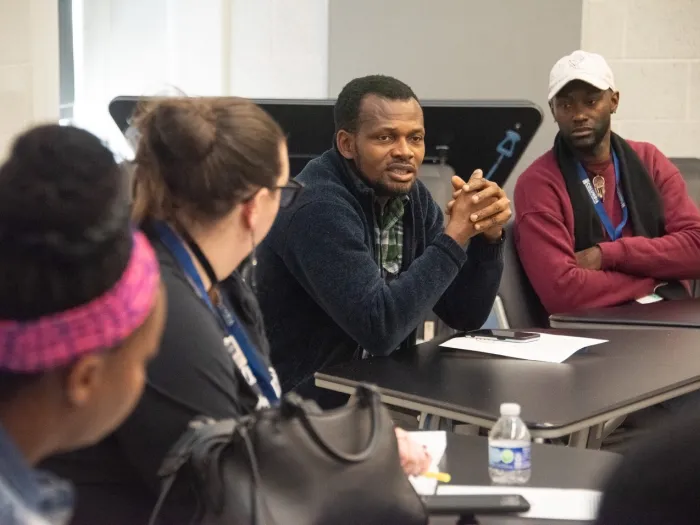Tres Rios Border Foundation continues vital work even as new migrations are halted
Border encounters, direct support are among the important services offered

Although a series of executive actions in late January 2025 effectively stopped the flow of those seeking to migrate to or apply for asylum in the United States, the Tres Rios Border Foundation is continuing its work of supporting those serving the needs of people who have migrated or are being expelled from the country.

Located a minute’s walk from the border fence that separates El Paso, Texas, from Juarez, Mexico, Tres Rios Border Foundation engages in a ministry of direct support for migrant shelter leaders, the witness of “border proximity,” being physically present with partners, and providing border encounters for Presbyterians and others interested in the human cost of migration.
The Rev. Dr. John Nelsen is a long-time border advocate who serves as partner liaison for the group. He’s seen the activities of the group, and its predecessor organization the Presbyterian Border Ministry, change over the 33 years he’s been active at the border, but the mission has stayed the same. Shifting immigration policies, overwhelming needs, and a changing legal and political landscape have all required Tres Rios Border Foundation to adapt.
“We are still here,” Nelsen said of the fear that was inspired by the cartel wars back in 2009-2013. “The reality then was that we still went across (the border to be with partners). And now because of the pressing need of immigration, it had to become our thing because we were seeing massive numbers of people migrating.”
The group incorporated under Tres Rios Presbytery in 2020 and soon hired a part-time director. It also made the strategic decision to partner with Abara, which means “a ford or crossing,” as a group also providing direct services at the border.
“The mission is to inspire, equip and connect PC(USA) congregations on both sides in U.S.-Mexico border and beyond toward loving God and their neighbor,” says the Rev. Marta Pumroy, who has served as Tres Rios Border Foundation’s Border Ministry Coordinator since September 2024.
She says a main focus of the group at this time is narrative change around migration and immigration, countering the “negativity and lies” about those migrating, their motivations and their character.
A second focus is systems change, “because once you hear these stories of what's happening, you’ll find out the systems are flawed — they've always been flawed,” says Pumroy. “It doesn't matter who's been in charge, we haven't been (treating migrants) in the way that I would say is Christian — as people who read the scriptures and believe in the scriptures. How we treat our neighbor and how we treat the immigrant and the foreigner is not the way our policies have been put into practice.”
Finally, personal change is a third focus. Pumroy says that’s where those who have learned the stories of migrants and asylum seekers start to work on their behalf.
“Anybody can enter in any of those points and participate in this type of mission work,” she says.
With the flow of migrants into the U.S. at a standstill and asylum applications on indefinite hold, the mission of education and transformation continues for Tres Rios Border Foundation, along with the important work of supporting the network of shelters that help deported persons get a footing while they await repatriation to destinations in Mexico or other countries.
Pumroy says the mission entails “being in connection with our hospitality sites, being able to go over to Juarez and talk to the shelters there and see what their needs are and meet face-to-face where our offices are located.” They rent space from their partner Abara, in Abara House, “which is a historic crossing from north to south as well as a passing to east to west with the railroad track.”
Of the 26 shelters in Juarez, Tres Rios Border Foundation supports Abara’s network of 12 shelters — most housed in churches and served by pastors. Through Abara, they host a quarterly luncheon where pastors and their families unite for fellowship and spiritual refreshment. They provide necessary car maintenance and repairs for these pastors who often use their personal vehicles to transport migrants to various appointments. They’ve offered money and opportunities for pastors to have respite, such as having a meal out or taking in a movie, and funded vacations to be reunited with their families they have not seen in four years due to the nonstop requirements of serving both a church and a shelter.
“These pastors are killing themselves,” Nelsen says. “They’re serving the church and the shelter, and I tell everyone in my presentations how committed they are.”
In 2024, Abara hosted 33 border encounters; Tres Rios Border Foundation hosted six. Each encounter is a three-day educational excursion for groups on both sides of the border. The group’s schedule has filled for 2025 and they’re asking people to look at 2026 for future border encounter bookings.
Funded by presbyteries, a few churches and many individual donations, with additional funding, Tres Rios Border Foundation believes it could expand its border encounter offerings and support for shelters and hospitality sites in El Paso and Juarez.
The encounters are an opportunity for Presbyterians to meet people who live on the border, who serve in border communities, and to form their own opinions — based on their faith — on how migrants and migration should be addressed in our churches and in government.
“We're living our faith values,” says Nelson of the group’s activities. “Does that have political implications? Yep. Is that what we lead with? Nope.”
Pumroy says border encounters are an essential means of inviting people into the work Tres Rios Border Foundation is doing, and that Presbyterians have done in border regions for generations. Relationships, she insists, change the narrative and bring broader understanding to how issues of migration affect all people.
“The border is not just a crisis,” she insists. “The border is also joy.”
You may freely reuse and distribute this article in its entirety for non-commercial purposes in any medium. Please include author attribution, photography credits, and a link to the original article. This work is licensed under a Creative Commons Attribution-NonCommercial-NoDeratives 4.0 International License.




